Philodendron esmeraldense is part of the vast genus known as Philodendron. This plant is a Broadleaf Philodendron famous for its foliage and is native to Lita, Ecuador.
The plant’s first known introduction was done by the Botanist named Dr. Tom Croat in the year 2008. This plant is named Esmeraldense because it occurs in Esmeraldas.
Philodendron esmeraldense Care
To care for Philodendron esmeraldense provide indirect sunlight as direct sunlight can damage it. Provide well-draining aroid soil. A temperature between 60ᵒF to 85ᵒF (16ᵒC – 29ᵒC) is best. Fertilize by-weekly using a liquid fertilizer in spring and summer. Fertilize once a month in autumn and winter.
Dr. Croat found this species growing in lower mountain regions as well as the wet rain forests. He determined this plant to be terrestrial and epiphytic. Remember these while creating a perfect indoor environment for your Philodendron Esmeraldense.
Philodendron esmeraldense has large dark green leaves that are glossy. The average matured leaf can be at least 19 inches long and 3 inches wide. The leaves also have a leathery feel and heavy veining. This plant can thrive both indoors and outdoors (USDA hardiness zones 9b-11), but many people prefer to keep it indoors.
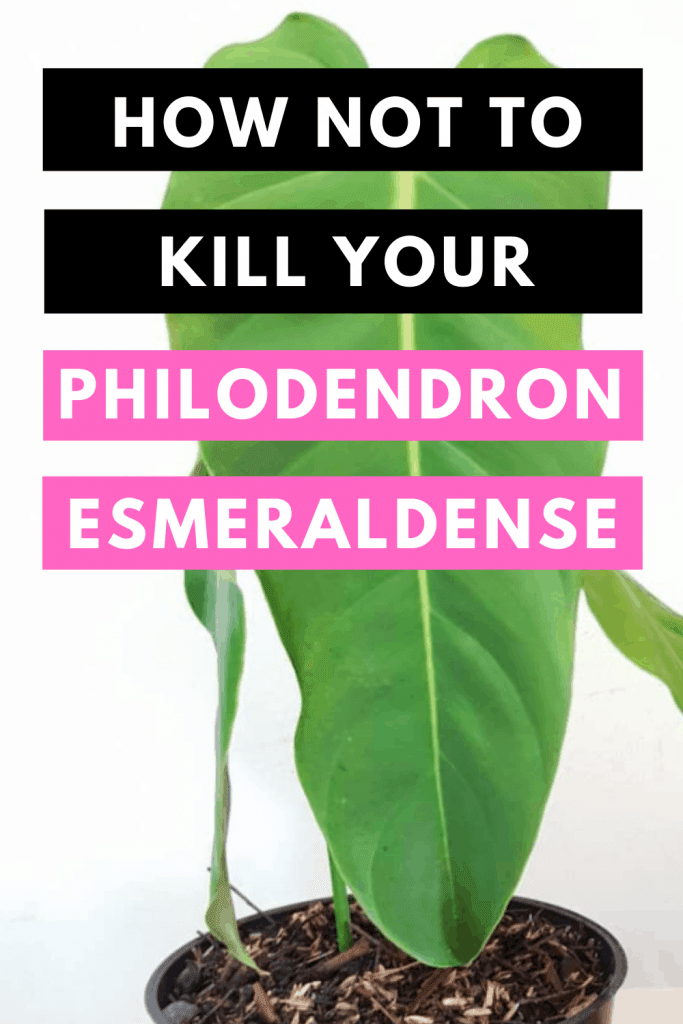
Philodendron Esmeraldense Care Photo Credit: @titikhijau on instagram
Table of Contents
Philodendron esmeraldense Care Video
Philodendron esmeraldense Care Guide
Soil
Soil that is well-drained and contains a large amount of organic matter is loved by Philodendron Esmeraldense. Never leave the soil too dry or sandy; always keep it moist.
You can add perlite and peat moss to your soil mixture to loosen it up. Keep the soil’s pH in the range of 5.5 (slightly acidic) to 6.9(neutral), as this is the optimum pH for Philodendron Esmeraldense.
Water
Philodendron Esmeraldense loves slightly moist soil. Overly soggy soil is dangerous for this plant as it can cause the leaves to turn yellow.
During the summer season, water your plant thrice a week. Make sure to only water it moderately. However, during the winter season, you only need to water your plant once a week.
To know when exactly you must water your plant, just make sure that it is 90% dry before its next watering session.
Over-watering your plant can cause fungus in the plant, which can lead to the rotting of roots and dropping.
Light
Philodendron Esmeraldense is not fond of high-intensity light. It can survive under direct sunlight, but if the light is too intense, then it can harm your plant.
For lighting, keep your Philodendron Esmeraldense under indirect sunlight by placing it by a window. Not providing enough sunlight to your plant can cause the stems and leaves to elongate, making them weaker, and anything can easily damage them.
Under low light, your Philodendron Esmeraldense will also become susceptible to disease, and the flowers won’t bloom properly. Too much light can cause the leaves to turn yellow or slightly red, and the leaf’s appearance also starts to look contorted.
Remember, too much direct sunlight can cause your plant to burn; thus, it is best to completely avoid direct sunlight.
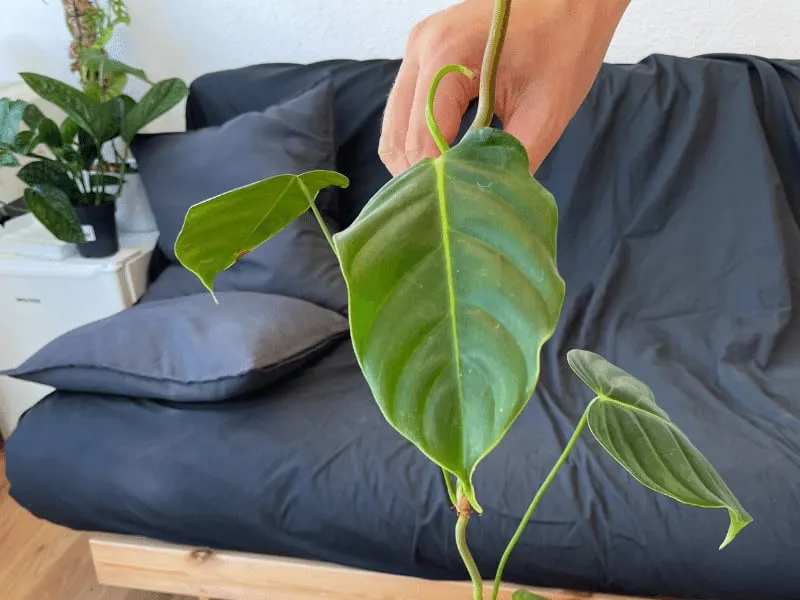
Bright indirect light is best for Philodendron esmeraldense
Temperature
Philodendron Esmeraldense responds best to a temperature that lies between the range of 60ᵒF to 85ᵒF (16ᵒC – 29ᵒC). Cooler temperature can cause the leaves to drop or damage them if exposed for too long.
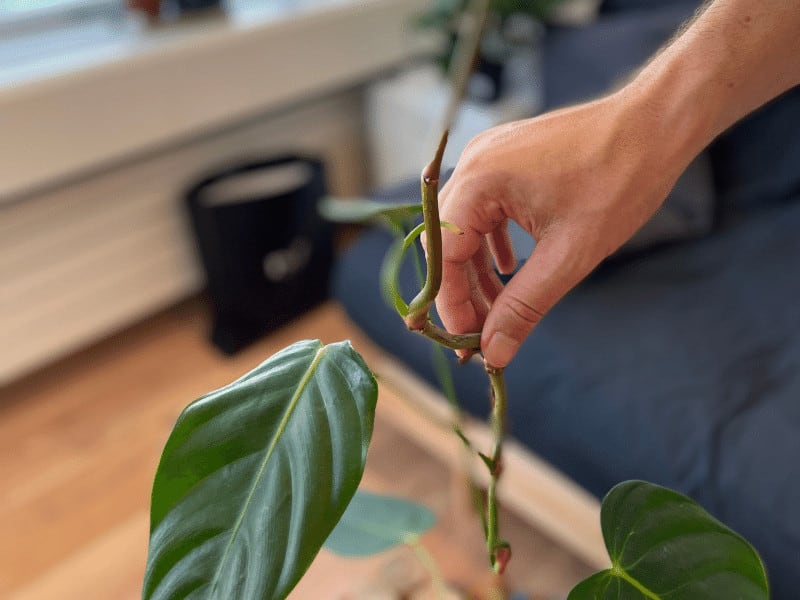
The ideal temperature for Philodendron esmeraldense is between 60ᵒF to 85ᵒF (16ᵒC – 29ᵒC)
Humidity
Philodendron Esmeraldense loves to be surrounded by high humidity levels. This can range from 70 to 80%, and it doesn’t matter whether it’s outdoors or indoors.
The humidity you provide for your plant should be a combination of warm and damp and not cold and damp.
Having a cold and damp environment can be harmful to your plant; this is because excess moisture is an invitation to fungus and other diseases.
During spring and fall, you can easily achieve the perfect humidity levels for Philodendron Esmeraldense.
In summer, lack of moisture can reduce humidity levels around the plant; this is why during the hottest part of the day, you should mist your plant and provide it with an adequate amount of water.
You can also place a tray of pebbles that is filled with water to help regulate the moisture levels around the plant.
Remember to regularly check the water levels in the pebble tray because there is no way for humidity to rise if there is no more water available.
The hardest part of growing Philodendron Esmeraldense is maintaining the humidity levels since most other plants prefer a much drier environment.
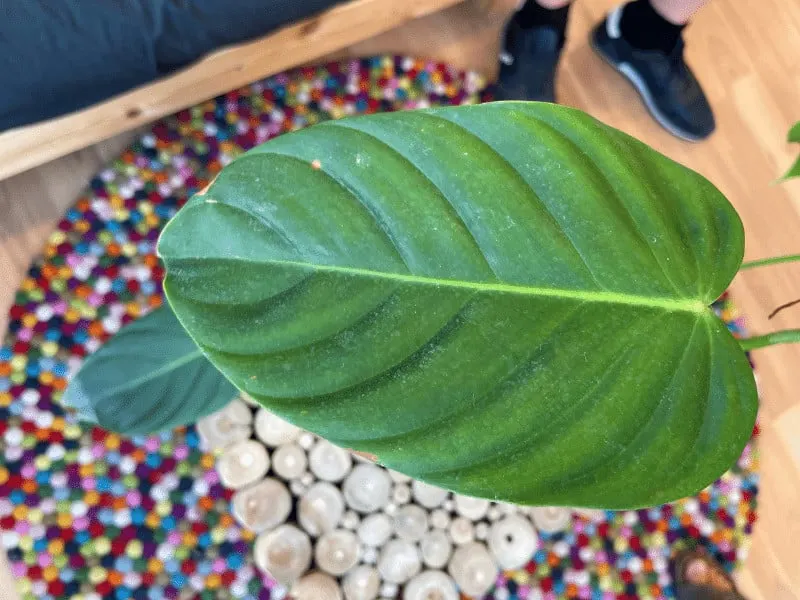
Philodendron esmeraldense needs 60% or more humidity to thrive
Fertilizer
Fertilizer is a big part of Philodendron Esmeraldense’s growth, as a lack of nutrition can cause its growth to slow down. Not fertilizing your Philodendron Esmeraldense can also cause underdevelopment and an unhealthy plant.
You can use any houseplant fertilizer and follow the given instructions on the packet. Remember to fertilize your Philodendron Esmeraldense every month during its growing season.
However, do not over-fertilize your plant and fertilize it only once in three months during the winter and fall season. But if you tend to use a slow-release fertilizer, then just use it thrice a year.
Repotting
To make sure that your Philodendron Esmeraldense does not become root bound, you need to shift it to a new pot that is slightly larger than the one used before.
Philodendron Esmeraldense tends to slow down its growth if it is close to being root-bound.
Repotting your plant has several benefits such as good growth stimulation and a healthier/greener looking plant.
Make sure that when you repot your plant, it has proper drainage holes in it so that it can have properly drained soil.
Pruning
Philodendron Esmeraldense does not need a lot of pruning, but if you wish to keep a certain esthetic for the plant, then you can cut off some leaves and stems.
In order to prune your Philodendron Esmeraldense, follow these steps:
- Before you start to prune, sanitize your equipment. Clean your shears or gardening scissors with rubbing alcohol.
- Wash your hand thoroughly to prevent the spread of pests and diseases.
- Pinch back, or you can cut off the stem tips after you see new growth during the spring season, do this when the tips are 3 to 6 inches long.
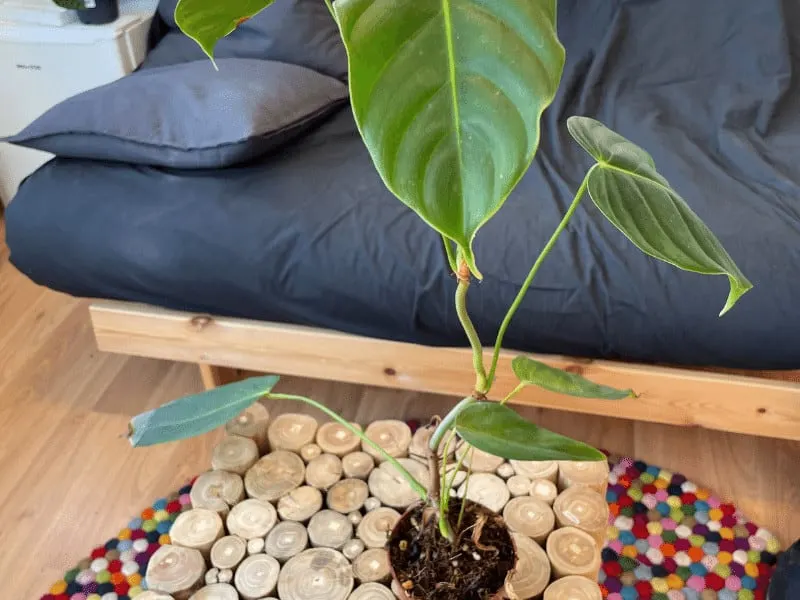
Provide a moss pole or trellis for Philodendron esmeraldense to climb
Propagation
Philodendron Esmeraldense can be propagated in the spring season because this is when they come out of their dormant phase. You can easily propagate Philodendron Esmeraldense in water and soil in two ways: stem cutting and tip cutting.
The first thing you will have to do for both processes is sanitize your equipment. If you do not do this step, there are chances of your spreading germs and thus causing infection. Remember to wear protective clothing as you, too, can get hurt in this process.
If you are going to propagate your plant through stem cutting, then cut off about two to three inches of the stem; use a sharp knife, gardening scissors, or shears to do this.
If you decide to use the tip cutting method, then cut a section of the stem (again two to three inches long) and make sure that it has some leaves on the tips.
Propagation in Water
- Fill in a jar with water and place your stem cutting into it. Do not fill in the jar till the top. Leave at least one inch free from the rim.
- You can also leave the water overnight to allow the chlorine to dissipate before you start propagating your plant.
- Place the stem cutting in the jar. Make sure that at least one or two nodes come under the waterline and leave at least two to three leaves above the waterline.
- Place the jar in a warm, bright area and let the roots grow.
- Regularly change the water. Keep the water changing intervals between two to three days and make sure to never leave the jar under direct sunlight. If you do not take care of this, then it could allow algae to grow.
- Once the roots start to appear, you can shift the plant into a pot filled with soil and water it as you would a plant mature.
Propagation in Soil
- Prepare a pot filled with suitable soil and water it.
- Put the cutting into the prepared soil.
- You should then cover your plant pot with a plastic bag to create a cheap version of a greenhouse. This will allow moisture to build up. Do make sure to air out the plastic bag every once in a while so that there isn’t any microbial growth.
- Keep the soil moist when you water it. Make sure it is not soggy.
- Keep temperatures warm, preferably 70ᵒF to 75ᵒF (21ᵒC to 23ᵒC)
- Make sure that the plant roots are growing in. To do this, you simply have to slightly pull the plant, and if you feel some resistance, it means the roots are strong.
- If it gives a good amount of resistance, then shift the plant into a new pot that is slightly bigger than the old one.
- You can also dip the new roots into some growth hormones, but this part is not necessary.
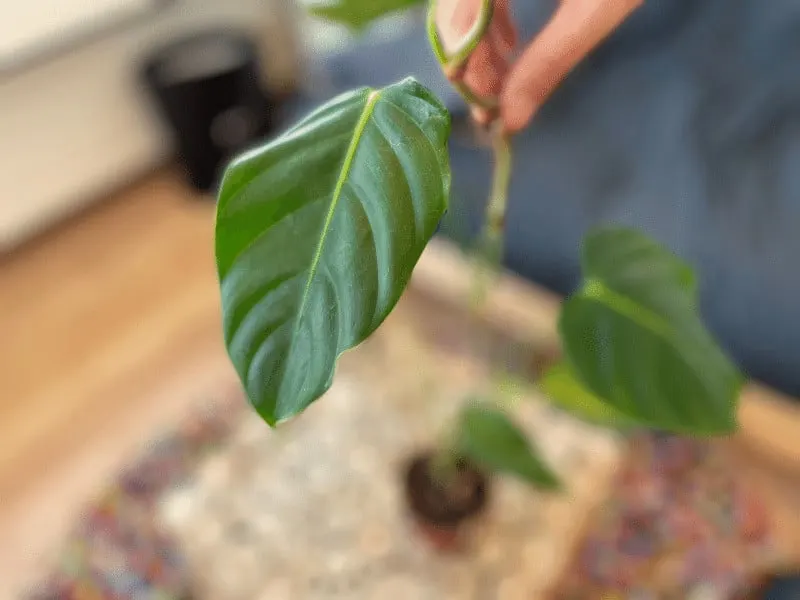
Philodendron esmeraldense has beautiful green foliage with a light green midrib
Blooms
Philodendron Esmeraldense does not bloom often. The plant will only bloom once it has become an adult or has hit its “mature” stage.
Oftentimes, Philodendron Esmeraldense owners confuse the inflorescence that consists of spathe and spadix as flowers. However, these are just modified leaf blades.
The “spadix” is what supports the tiny flowers and is located in the middle of the inflorescence. These flowers can be male or females.
Philodendron Esmeraldense is dependent on pollination by insects such as butterflies, beetles, and bees.
Growth
Philodendron Esmeraldense can reach up to a height of 72 inches to 96 inches (6 to 8 feet). This plant is a vine and is growing as it climbs up; thus, if you wish your plant to stay upright, then remember to use a support rod in the pot to help support the plant.
The dark green leaves for this species are ovate to sagittate and possess a velvety sheen. The underside of the leaves has a pale purplish tinge, whereas the top surface is green with slight wrinkles. The cylindrical petioles generally grow 9 to 29 inches in length.
You will often find this plant growing along with trees as they can provide them with proper support. Philodendron Esmeraldense has a fast-growing rate, just like any other Philodendron.
View this post on Instagram#philodendronesmeraldense #philodendronbillietiaevariegated will be ready on spring ??
Common Problems for Philodendron esmeraldense
Pseudomonas Leaf Spot
Pseudomonas is the reason behind why the leaves on your Philodendron Esmeraldense appear distorted and have reddish-brown spots on them. The pseudomonas bacteria tend to survive in dead plants or dead parts of the plant.
Pseudomonas tend to not survive long in water or in soil. The bacteria are weak and need natural openings in a plant such as a stomate, or an injury, to infect the plant.
Do not work on the plant while it is still wet since injuries caused by equipment can cause the disease to spread. You cannot use fungicides on the plant as it is infected with bacteria and won’t have any effect on it. The best solution is to use sanitized equipment.
Xanthomonas Leaf Spot
Bacterial leaf spots are a common occurrence on many plants. The cause behind these spots is the bacteria called Xanthomonas campestris, which is capable of infecting the majority of plants.
Xanthomonas campestris is a member of the genus Xanthomonas. Xanthomonas are tiny microorganisms that are capable of moving a short distance in the water. Xanthomonas leaf spots tend to be different on every plant that they infect. One of the most common symptoms includes the formation of spots between leaf veins.
The only solution available for Xanthomonas Leaf Spots is following proper equipment sanitation methods and proper watering for each plant.
Aphids
Aphids are small insects that have soft-bodies and tend to suck out the nutrients in the plants. They also have a reputation of never leaving any plant alone.
Suppose the number of aphids affecting your plant is large, then they can significantly weaken your plant, which in return harms the flowers. Aphids tend to multiply fast; thus, it is important for you to get rid of them as soon as possible before they start reproducing.
Several generations of aphids can be produced within one season. But don’t worry, they tend to move around extremely slowly, so this makes it easier to get them under control,
The size of aphids is so small that even an adult is only ¼ inches long; this is why they are extremely hard to spot with just your eyes. However, using a magnifying glass can help in this case.
There are also several species of aphids, and their colors range from black, brown, gray, green, or pink as well. Some aphids can also have a waxy or woolly coating. Their bodies are pear-shaped and have long antennae attached to them.
To remove aphids, you need to spray them with cold water. Once they have been blasted off of the plant with cold water, they can never find their way back to the same plant.
If your plant faces an invasion from a large group of aphids, you can also try dusting the plant with flour. This method will constipate pests.
You can also use insecticidal sprays or neem oil to get rid of aphids. However, if you tend to use these two, then make sure to follow the instructions that have been provided on the package.
Mealybugs
Mealybugs are not a new name if you already own a plant. These pests tend to grow in warmer climates and have soft bodies that do not have wings on them. They appear to be white on the leaves and stems of a plant, which makes them hard to spot.
Adult mealybugs are somewhere between 1/10 inch to 1/4 inch long. They are also soft, have oval bodies, and are usually covered with white or gray mealy wax.
Another name for these insects is crawlers. This insect is quite active at first but slowly moves on once it finds a more suitable feeding site.
To avoid getting mealybugs, never over-water or over-fertilize your plant. If your plant is already infested with mealybugs, then simply take a cotton bud or a cotton pad and dip it in rubbing alcohol. Then dab the mealybugs with the cotton filled with alcohol.
Tips for Growing Philodendron esmeraldense
- Never overwater it, as it encourages diseases and root-rot.
- Never over-fertilize it; else, your plant will be suffocated by salt buildups.
- Provide it with indirect sunlight.
- Always use sanitized equipment when pruning your plant.
- Have proper drainage holes in the pot.
Frequently Asked Questions about Philodendron esmeraldense
Is Philodendron esmeraldense toxic for pets?
The Philodendron Esmeraldense is toxic. Almost every Philodendron plant is toxic so if you own any other Philodendron plants, make sure to keep pets as well as babies away from them.
How long will my Philodendron esmeraldense live?
Just like other Philodendrons, the Philodendron Esmeraldense also has a long life and can live for many many years.
Why is my Philodendron esmeraldense turning yellow and wilting?
Overwatering your plant can cause the plant to turn yellow or make it wilt. Improper drainage can also be another reason behind yellow leaves, so make sure your pots have proper drainage holes.
Why does my Philodendron esmeraldense have brown spots on it?
An excessive amount of direct sunlight is not good for Philodendron Esmeraldense. If you over-expose your Philodendron Esmeraldense to direct sunlight, then the leaves start to burn and become brown.
Conclusion About Philodendron esmeraldense Care
Water Philodendron esmeraldense about once a week when the top 2-3 inches of soil are dry (5.0-7.5 cm). Provide bright indirect sunlight and a temperature between 60ᵒF to 85ᵒF (16ᵒC – 29ᵒC). Fertilize every two weeks in spring and summer and once a month in autumn and winter using a liquid fertilizer.

Daniel has been a plant enthusiast for over 20 years. He owns hundreds of houseplants and prepares for the chili growing seasons yearly with great anticipation. His favorite plants are plant species in the Araceae family, such as Monstera, Philodendron, and Anthurium. He also loves gardening and is growing hot peppers, tomatoes, and many more vegetables.


